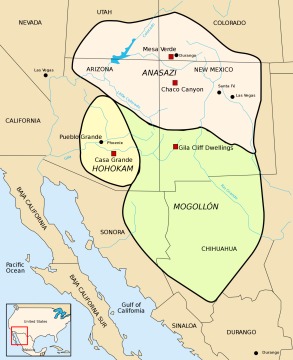3000 BC: Southwestern peoples plant corn, beans, squash; population grows
Ancestors of the Mogollón, Hohokam, and Puebloan peoples begin horticulture in the lands now known as New Mexico and Arizona. Unlike a random harvest from wild crops, predictable yields from gardens of corn, beans, and squash let families increase in numbers. Cultural arts flourish.
Mogollón, Hohokam, and Puebloan ancestors develop a planting pattern to compensate for an arid climate. They trellis bean vines on corn stalks and plant big-leafed squash over the other plants’ fragile roots to shade them and hold in precious water. They supplement garden plants with game and wild piñons, and desert succulents, returning seasonally to regular places to gather wild crops. Although corncobs in this era are tiny compared with those selected and bred in later centuries, regular harvests can support growing families.
- Theme
- Land and Water
- Region
- Southwest
Map showing extent of Anasazi, Hohokam, and Mogollón settlements in what is now known as New Mexico and Arizona
